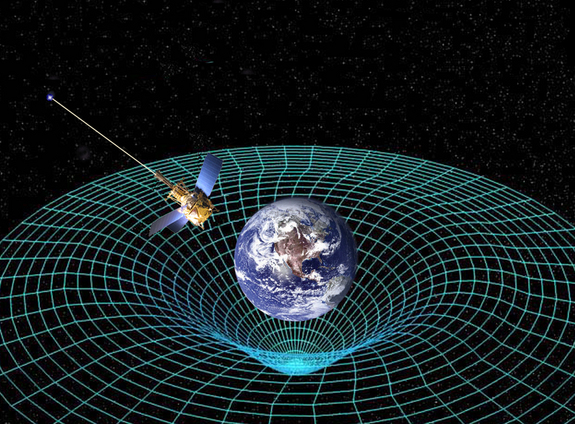Will Einstein's General Relativity Break Under Extreme Conditions?

A century ago this year, a young Swiss physicist, who had already revolutionized physics with discoveries about the relationship between space and time, developed a radical new understanding of gravity.
In 1915, Albert Einstein published his general theory of relativity, which described gravity as a fundamental property of space-time. He came up with a set of equations that relate the curvature of space-time to the energy and momentum of the matter and radiation that are present in a particular region.
Today, 100 years later, Einstein's theory of gravitation remains a pillar of modern understanding, and has withstood all the tests that scientists could throw at it. But until recently, it wasn't possible to do experiments to probe the theory under extreme conditions to see whether it breaks down. [6 Weird Facts About Gravity]
Now, scientists have the technology to begin looking for evidence that could reveal physics beyond general relativity.
"To me, it is absolutely amazing how well general relativity has done after 100 years," said Clifford Will, a theoretical physicist at the University of Florida in Gainesville. "What he wrote down is the same thing we use today," Will told Live Science.
A new view of gravity
General relativity describes gravity not as a force, as the physicist Isaac Newton thought of it, but rather as a curvature of space and time due to the mass of objects, Will said. The reason Earth orbits the sun is not because the sun attracts Earth, but instead because the sun warps space-time, he said. (This is a bit like the way a bowling ball on an outstretched blanket would warp the blanket's shape.)
Get the world’s most fascinating discoveries delivered straight to your inbox.
Einstein's theory made some pretty wild predictions, including the possibility of black holes, which would warp space-time to such a degree that nothing inside — not even light — could escape. The theory also provides the foundation for the currently accepted view that the universe is expanding, and also accelerating.
General relativity has been confirmed through numerous observations. Einstein himself famously used the theory to predict the orbital motion of the planet Mercury, which Newton's laws cannot accurately describe. Einstein's theory also predicted that an object that was massive enough could bend light itself, an effect known as gravitational lensing, which astronomers have frequently observed. For example, the effect can be used to find exoplanets, based on slight deviations in the light of a distant object being bent by the star the planet is orbiting.
But while there hasn't been "a shred of evidence" that there's anything wrong with the theory of general relativity, "it's important to test the theory in regimes where it hasn't been tested before," Will told Live Science.
Testing Einstein's theory
General relativity works very well for gravity of ordinary strength, the variety experienced by humans on Earth or by planets as they orbit the sun. But it's never been tested in extremely strong fields, regions that lie at the boundaries of physics. [The 9 Biggest Unsolved Mysteries in Physics]
The best prospect for testing the theory in these realms is to look for ripples in space-time, known as gravitational waves. These can be produced by violent events such as the merging of two massive bodies, such as black holes or extremely dense objects called neutron stars.
These cosmic fireworks would produce only the tiniest blip in space-time. For instance, such an event could alter a seemingly static distance on Earth. If, say, two black holes collided and merged in the Milky Way galaxy, the gravitational waves produced would stretch and compress two objects on Earth that were separated by 3.3 feet (1 meter) by one-thousandth the diameter of an atomic nucleus, Will said.
Yet there are now experiments out there that could potentially detect space-time ripples from these types of events.
"There's a very good chance we will be detecting [gravitational waves] directly in the next couple of years," Will said.
The Laser Interferometer Gravitational-Wave Observatory (LIGO), with facilities near Richland, Washington, and Livingston, Louisiana, uses lasers to detect miniscule distortions in two long, L-shaped detectors. As space-time ripples pass through the detectors, the ripples stretch and compress space, which can change the length of the detector in a way that LIGO can measure.
LIGO began operations in 2002 and has not detected any gravitational waves; in 2010, it went offline for upgrades, and its successor, known as Advanced LIGO, is scheduled to boot up again later this year. A host of other experiments also aim to detect gravitational waves.
Another way to test general relativity in extreme regimes would be to look at the properties of gravitational waves. For example, gravitational waves can be polarized, just like light as it passes through a pair of polarized sunglasses. General relativity makes predictions about this polarization, so "anything that deviates from [these predictions] would be bad" for the theory, Will said.
A unified understanding
If scientists do detect gravitational waves, however, Will expects it will only bolster Einstein's theory. "My opinion is, we're going to keep proving general relativity to be right," he said.
So why bother doing these experiments at all?
One of the most enduring goals of physics is the quest for a theory that unites general relativity, the science of the macroscopic world, and quantum mechanics, the realm of the very small. Yet finding such a theory, known as quantum gravity, may require some modifications to general relativity, Will said.
It's possible that any experiment capable of detecting the effects of quantum gravity would require so much energy as to be practically impossible, Will said. "But you never know — there may be some strange effect from the quantum world that is tiny but detectable."
Follow Tanya Lewis on Twitter. Follow us @livescience, Facebook & Google+. Original article on Live Science.



